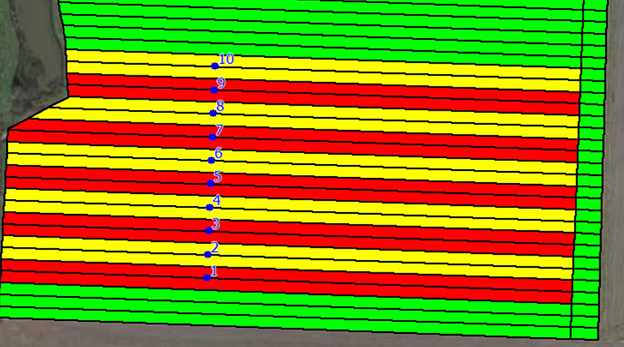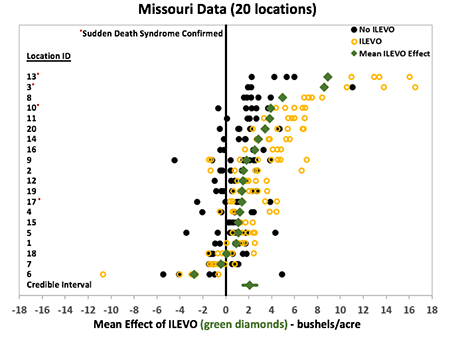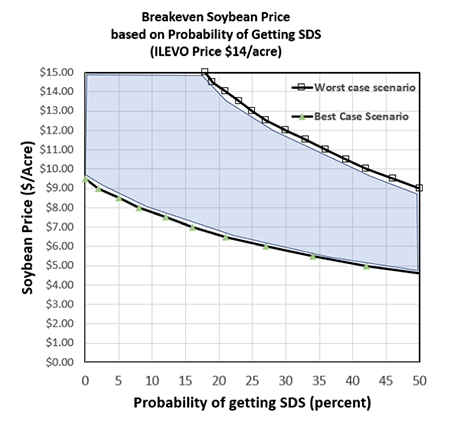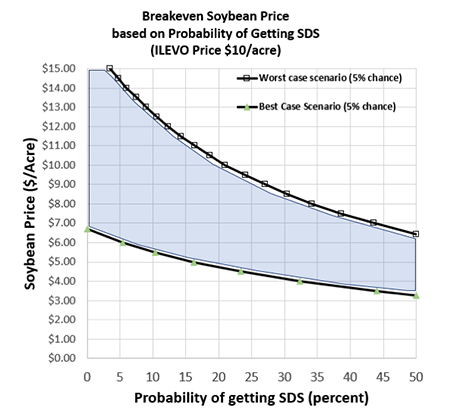ILeVO is a seed treatment that is labeled to decrease the incidence of sudden death syndrome (SDS) and to reduce the occurrence of soybean cyst nematode (SCN) numbers in the soil.
ILeVO is a registered trademark of BASF.
SDS symptoms

ILeVO trials and results
Sudden death syndrome (SDS) is caused by the soil-borne fungus Fusarium virguliforme entering plants through the root system and results in defoliation and premature plant death. Additionally, SDS symptoms can increase in severity when soybean cyst nematode (SCN) is present. The fungicide/nematicide seed treatment ILeVO (active ingredient fluopyram) has shown benefits for protection of soybean seedlings from SDS and also for activity against SCN.
This trial was set up to test soybean treated with the high rate of ILeVO Seed Treatment versus soybean not treated ILeVO Seed Treatment to test the effect of ILeVO seed treatment on SDS occurrence, SCN populations and soybean yield.
Key question:
Does high rate of ILEVO™ seed treatment reduce nematode reproduction and increase yield?
Treatments:
Farmer seed treatment (No ILeVO™) vs. farmer seed treatment plus high rate of ILeVO™ (1.98 ounces per 140,000 seeds).
Location of the trials:

Trials initiated on 29 farms; data retained from 20 trials. Eliminated trails due to crop failure (1), planting (2) or harvest issues (3), and fewer than eight strips (3).
Strip Trial Project Leadership Team:
John Lory, MU Extension, Nutrient Management
Kaitlyn Bissonnette, MU Extension, Field Crop Pathologist
Peter Scharf, MU Extension, Nutrient Management
Greg Luce, MU Extension, Missouri Soybean Association, Agronomist
Bill Wiebold, MU Extension, Soybean Specialist (ret.)
Kent Shannon, MU Extension, Agricultural Engineer
Wayne Flanary, MU Extension, Agronomist
Each ILeVO trial is custom designed to work within the individual farmer’s designated field using their own equipment to plant and harvest the treatment strips in their field. Each farmer chooses the variety of soybean to be planted. Each field is laid out with a minimum of five strips of ILeVO treated seed and five strips of seed not treated with ILeVO.
In the example below, red is the strips of ILeVO treated seed, yellow is the strips of non-ILeVO treated seed, green is rest of the field. The blue points are where soil samples were taken at planting and at the end of the growing season to test for SCN. In this example, the farmer made two passes with the planter for each treatment.

Key results
- ILeVO increased yield in the Missouri trials. On sites with SDS there was a 50% chance of a response of 3.5 bushels per acre or more. On sites with no SDS, there was a 50% chance of a response of one bushel per acre or more.
- There was evidence that the high ILeVO rate reduced the SCN reproductive factor; the effect of ILeVO was greater at locations with higher SCN reproduction.
- In Iowa, there was no evidence that ILeVO increased yields on fields with SDS and the potential response on other fields was less than on Missouri fields.
Project summary
- Soybean cyst nematode (SCN) and sudden death syndrome (SDS) are the top two pathogens reducing soybean yield.
- The seed treatment ILeVO™, when applied at the high rate, is labeled for control of both pathogens.
- The “MU Certified” strip trial program initiated 29 trials on Missouri farmer fields in 2017 and 2018. This analysis used data from 20 locations.
- The trials compared the farmer seed treatment (no ILeVO) versus the farmer seed treatment plus the high rate of ILeVO.
- The trials evaluated yield response and impact on SCN reproductive factor.
- Iowa Soybean Association provided yield data from 23 trials on Iowa farms in 2015 and 2016.
- SDS was confirmed at four of the MO locations and four of the IA locations.
Missouri ILEVO strip trial data set

- On these 20 farms, there was a >50% chance that ILeVO increased yield 2.0 bushels per acre.
- On farms with SDS confirmed in the field (n=4) there was a 50% chance of yield >3.5 bushels per acre.
- For fields where SDS was not confirmed, it was unlikely the benefit of SDS exceeded 1.0 bushel per acre.
Missouri plus Iowa ILEVO strip trial data set
Response of soybean yield to ILEVO seed treatment with or without the confirmed presence of sudden death syndrome (SDS)

Iowa response (2015-2016 data) to ILeVO was less than response on Missouri fields. In contrast to Missouri sites, there was no evidence in Iowa that ILeVO increased yield at sites where SDS was confirmed.
Missouri ILEVO strip trial data set: SCN numbers
Note: Rf = SCN reproductive factor calculated as the ratio of harvest SCN egg numbers divided by initial SCN egg numbers. When Rf=1, there was no change in SCN egg counts over the growing season.

- SCN data, both egg counts and Rf, were highly variable within locations. This is common with SCN data.
- Higher Rf increase the effect of ILeVO. Using all data ILeVO reduced Rf >50%. For locations with Rf<10, ILeVO reduced Rf about 20%.

Interpretation:
- Select the probability that you will get SDS on your farm. If you expect SDS once every five years, select 20%.
- The best- and worst-case scenarios are based on Missouri results in the Table below. For example, the best-case scenario line assumes a yield benefit of ILeVO of 1.5 bushels per acre with no SDS and 4.6 bushels per acre with SDS.
- The y-axis represents the break-even price of soybean for ILeVO assuming ILeVO costs $14 per acre.
- If you expect SDS 20% of the years and the best-case scenario, the break-even price of soybean is about $6.50 per bushel.

Key points:
Value of ILeVO to you depends on your situation.
- A high expectation of having SDS and an expectation benefits are on the upper limit of Missouri response, ILeVO always pays.
- If SDS occurs infrequently and/or there is no expectation of a big yield benefit from ILeVO, it will not pay at today’s prices.

Key points:
When the price of ILeVO decreases to $10 per acre:
- When expectation of benefits are on the upper limit of Missouri response, ILeVO always pays.
- If there is no expectation of a big yield benefit from ILeVO, then ILeVO only pays on fields with a significant expectation of SDS.
2018 locations
- Ralls County (PDF)
- Lafayette County (PDF)
- Barton County (PDF)
- Barton County (PDF)
- Lincoln County (PDF)
- Warren County (PDF)
- -------------
- Knox County (PDF)
- Audrain County (PDF)
- Barton County (PDF)
2017 locations
- Lincoln County (PDF)
- Lincoln County (PDF)
- Ralls County (PDF)
- Lafayette County (PDF)
- Barton County (PDF)
- Lincoln County (PDF)
- Lincoln County
- Holt County (PDF)
- Warren County (PDF)
- Adair County (PDF)
- Lincoln County (PDF)
- Audrain County (PDF)
- Barton County (PDF)
- Audrain County (PDF)
- Audrain County (PDF)
- Barton County (PDF)
- Platte County
- Ralls County (PDF)
- Holt County (PDF)
- Lafayette County (PDF)
- SCN Diagnostics Plant and Nematode Screening Services(opens in new window)
- MU Guide G4450: Soybean Cyst Nematode: Diagnosis and Management(opens in new window)
- Dr. Bissonnette IPM articles on SDS and SCN, April 27, 2018: Early Season Soybean Diseases.
This on-farm research was supported by the Missouri Soybean Merchandizing Council (award No. 17-408) and University of Missouri Extension. This on-farm research was only possible with the cooperation of Missouri Soybean farmers who volunteered to implement trials on their fields and the Regional MU Extension faculty that supported them.